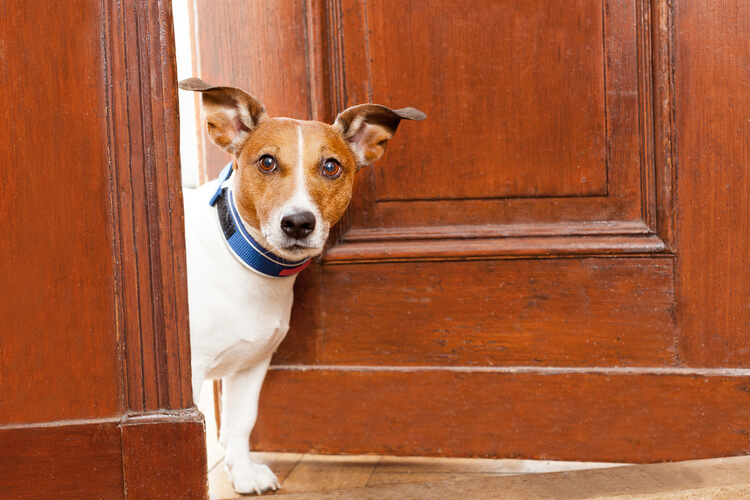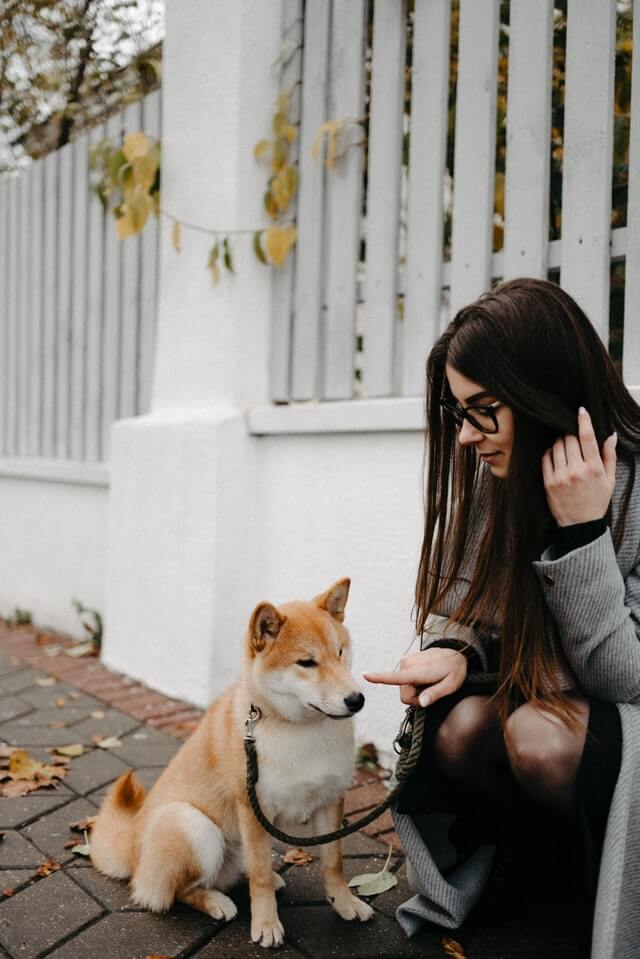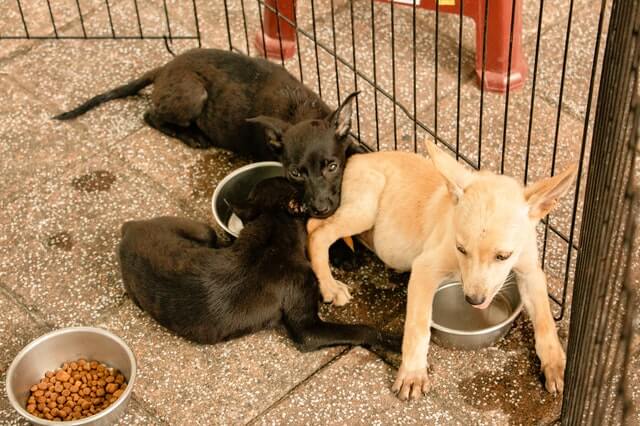Every dog owner knows that dogs can be curious, adventurous, and messy creatures – and that you have to train your dog to minimize the negatives. These characteristics often contribute to why we love our canine companions so much. However, they can also be reasons why boundaries are sometimes needed to keep a dog in a certain area or out of a particular space in your house. For example, you may want to keep your dog out of the bedroom so you can sleep better. You might want to keep them out of the kitchen to avoid them sneaking tasty (and sometimes dangerous) snacks, to keep the pet fur condiments on your food to a minimum, and to keep them out of the garbage. Perhaps you have a new baby, and you want to keep your dog out of the nursery so your baby (and you) can catch some much-needed ZZ’s or keep the dog away from dirty diapers and tiny baby toys. Whatever the reason may be, there are times you need to train your dog to keep out a certain room.
There are different methods and ways to effectively do this, all with varying success depending on your dog and your dog’s motivations and trustworthiness. Ultimately, it all boils down to training and teaching your dog what he or she can and cannot do and where they can and cannot go.
Here are some basic tips to keep your dog out of a room.
Basic Obedience: Train Your Dog
Image courtesy of Pexels
As previously mentioned, keeping your dog out of a particular room or space all boils down to training. It is extremely important to start with the basics and ensure your dog listens to simple obedience commands. If your dog doesn’t understand “no,” “sit,” “stay,” “off,” “heel,” or “out,” it will be incredibly difficult to teach them to avoid a room.
Start with working on these commands at home. Teach your dog to listen to “sit,” “stay,” “come,” “lay down,” and “heel”. Reward them when they listen – small, yummy treats, their favorite toy, or an affectional rub or pat on the head are great rewards. Of course, the best reward is what your dog responds to. Some are food motivated while others prefer toys or attention.1
Work with a trainer. Look for puppy or dog basic obedience classes. These may be at your local pet store, at your veterinary clinic, with a doggie daycare facility, or a private trainer. Do your research and make sure the trainer has been trained themselves, good reviews both online and from other clients, and check into their references.
Establish a Command Word
Once you and your pooch have the basic commands and obedience training down. Start with more specific training. Establish a command word specifically meant to communicate to your dog that a room is off-limits. This command could be “off” or “out.” Be consistent with the use of this word and follow through when you say it. Start by keeping your dog on a leash and walk by the room in question. If and when they try to enter, say your command word and direct your dog away from and out of the room. Then reward them. Do this consistently and work to walking by without a leash once your dog starts to understand.
It might be helpful to redirect your dog. Use your command and then redirect with another command. For example, your dog walks into the off-limits room, say “out” and when the dog walks out you reward him and then give a command such as “sit,” “stay,” or “lay down.” Again, when he does this, reward him. Eventually, you should be able to tell your dog to get out of the room and go lay down (with the hopes he goes and takes a nap).
Establish Boundaries
Using your command word and basic training techniques are all to help establish boundaries. The boundary is typically the entrance to a room but may even be the foot of the bed, the end of a hallway, the top or bottom of the stairs, or wherever else you may need it to be. Think of it as an invisible line that your dog should not cross.
Again, consistency is key! You don’t want to make special allowances to cross these boundaries or the next time your dog is unsupervised, they might take it upon themselves to enter as they please – the opposite of what you are aiming for.2
Use Barriers
Image courtesy of Pexels
For most dogs, the only reliable way to keep them out of a particular room or space is to use a physical barrier, especially when the dog is unsupervised. You might trust your dog to listen when they know you are around to enforce the rules, but the minute you leave, your dog might get other ideas.
The type of barrier you use will depend on the size of your dog, what room or space is off-limits, and how determined your dog is to get into that space.
Some examples include:
- Doors – Use a door that is already present or if the space allows have a door installed. Make sure the dog can’t easily access or use the door handle to open it.
- Gates – You can use a traditional baby gate, walk through the gate, or flexible fence-style barrier.
- Furniture – It might be easy enough to move an ottoman, chair, bench, or another piece of furniture to block your dog’s access to the room.
- Kennel or Crate – A simple way to keep your dog confined to a specific place or out of an area is to keep the dog housed in a kennel or crate when they are unsupervised.
- Pet locks – The use of pet locks can work to keep your dog out of certain smaller areas such as the pantry, in a cupboard, into a bathroom, or in the trash. Use locks such as baby or child-proof locks. Use a dog-proof trash can to keep them out of the trash.
Provide a Special Spot Just for Your Dog
It is important to make sure your dog understands where he or she cannot go but also that they have a safe and special spot just for them. This might be a place you use to redirect your dog when you tell them to leave a room and go to their special place.
A special spot might be the dog’s favorite spot on the sofa (or even a large dog bed on the couch), their outdoor dog bed (or whatever dog bed you have: an elevated dog bed or waterproof dog bed, for instance), their crate with their favorite blanket, a warm spot by the fire, or a comfy place by the window.
Provide a Distraction
Similar to redirecting, you can utilize distractions to keep your dog out of a room. Provide tasty durable chews or treats to keep their taste buds occupied. Give them a fun toy or mind-enriching puzzle to occupy their mind and distract them from wanting to go into the off-limits space.
More extreme distractions to consider if you are worried about your dog getting into a room while you are gone is taking your dog to doggie daycare, hiring a dog walker, or training your dog to use a treadmill (only the best dog treadmills, of course) to provide a fun distraction and exactly how much exercise your dog needs!
Whatever the room and whatever the reason, it is a good idea to establish some ways to keep your dog out of a room. This might even be for their own safety. Remember to give lots of positive reinforcement and provide fun distractions for your pup as well!
Article Sources
Pet News Daily uses only high-quality sources, including peer-reviewed studies, to support the facts within our articles. Read our editorial process to learn more about how we fact-check and keep our content accurate, reliable, and trustworthy.
- Greenebaum J B. Training Dogs and Training Humans: Symbolic Interaction and Dog Training. Anthrozoös. 2010; 23(2): 129-141. doi: 10.2752/175303710X12682332909936
- Vieira de Castro AC, Fuchs D, Morello GM, Pastur S, de Sousa L, Olsson IAS. Does training method matter? Evidence for the negative impact of aversive-based methods on companion dog welfare. PLoS One. 2020;15(12):e0225023. Published 2020 Dec 16. doi:10.1371/journal.pone.0225023.



